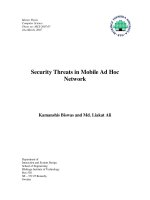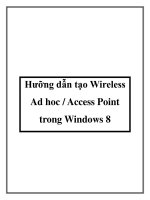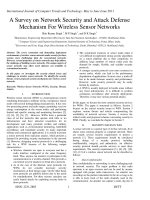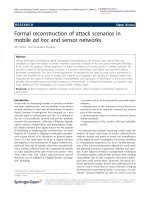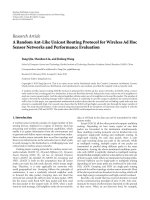Topology Control in Wireless Ad Hoc and Sensor Networks pdf
Bạn đang xem bản rút gọn của tài liệu. Xem và tải ngay bản đầy đủ của tài liệu tại đây (4.1 MB, 282 trang )
Simpo PDF Merge and Split Unregistered Version -
Simpo PDF Merge and Split Unregistered Version -
Simpo PDF Merge and Split Unregistered Version -
Topology Control in Wireless
Ad Hoc and Sensor Networks
Simpo PDF Merge and Split Unregistered Version -
Topology Control in Wireless
Ad Hoc and Sensor Networks
Paolo Santi
Istituto di Informatica e Telematica del CNR – Italy
Simpo PDF Merge and Split Unregistered Version -
Copyright 2005 John Wiley & Sons Ltd, The Atrium, Southern Gate, Chichester,
West Sussex PO19 8SQ, England
Telephone (+44) 1243 779777
Email (for orders and customer service enquiries):
Visit our Home Page on www.wiley.com
All Rights Reserved. No part of this publication may be reproduced, stored in a retrieval system or transmitted in
any form or by any means, electronic, mechanical, photocopying, recording, scanning or otherwise, except under
the terms of the Copyright, Designs and Patents Act 1988 or under the terms of a licence issued by the
Copyright Licensing Agency Ltd, 90 Tottenham Court Road, London W1T 4LP, UK, without the permission in
writing of the Publisher. Requests to the Publisher should be addressed to the Permissions Department, John
Wiley & Sons Ltd, The Atrium, Southern Gate, Chichester, West Sussex PO19 8SQ, England, or emailed to
, or faxed to (+44) 1243 770620.
This publication is designed to provide accurate and authoritative information in regard to the subject matter
covered. It is sold on the understanding that the Publisher is not engaged in rendering professional services. If
professional advice or other expert assistance is required, the services of a competent professional should be
sought.
Other Wiley Editorial Offices
John Wiley & Sons Inc., 111 River Street, Hoboken, NJ 07030, USA
Jossey-Bass, 989 Market Street, San Francisco, CA 94103-1741, USA
Wiley-VCH Verlag GmbH, Boschstr. 12, D-69469 Weinheim, Germany
John Wiley & Sons Australia Ltd, 42 McDougall Street, Milton, Queensland 4064, Australia
John Wiley & Sons (Asia) Pte Ltd, 2 Clementi Loop #02-01, Jin Xing Distripark, Singapore 129809
John Wiley & Sons Canada Ltd, 22 Worcester Road, Etobicoke, Ontario, Canada M9W 1L1
Wiley also publishes its books in a variety of electronic formats. Some content that appears
in print may not be available in electronic books.
Library of Congress Cataloging-in-Publication Data
Santi, Paolo.
Topology control in wireless ad hoc and sensor networks / Paolo Santi.
p. cm.
Includes bibliographical references and index.
ISBN-13: 978-0-470-09453-2 (cloth : alk. paper)
ISBN-10: 0-470-09453-2 (cloth : alk. paper)
1. Wireless communication systems. 2. Wireless LANs. 3. Sensor
networks. I. Title.
TK5103.2.S258 2006
004.6
8–dc22
2005013736
British Library Cataloguing in Publication Data
A catalogue record for this book is available from the British Library
ISBN-13 978-0-470-09453-2 (HB)
ISBN-10 0-470-09453-2 (HB)
Typeset in 10/12pt Times by Laserwords Private Limited, Chennai, India
Printed and bound in Great Britain by Antony Rowe Ltd, Chippenham, Wiltshire
This book is printed on acid-free paper responsibly manufactured from sustainable forestry
in which at least two trees are planted for each one used for paper production.
Simpo PDF Merge and Split Unregistered Version -
To my wife Elena,
my daughter Bianca,
and my children to be
To my families
Simpo PDF Merge and Split Unregistered Version -
Simpo PDF Merge and Split Unregistered Version -
Contents
About the Author xiii
Preface xv
Acknowledgments xix
List of Abbreviations xxi
List of Figures xxiii
List of Tables xxvii
I Introduction 1
1 Ad Hoc and Sensor Networks 3
1.1 TheFutureofWirelessCommunication 3
1.1.1 Adhocnetworks 3
1.1.2 Wirelesssensornetworks 5
1.2 Challenges 7
1.2.1 Adhocnetworks 8
1.2.2 Wirelesssensornetworks 9
2 Modeling Ad Hoc Networks 13
2.1 TheWirelessChannel 13
2.1.1 The free space propagation model . . . . . . . . . . . . . . . . . . 14
2.1.2 The two-ray ground model . . . . . . . . . . . . . . . . . . . . . . 14
2.1.3 Thelog-distancepathmodel 15
2.1.4 Large-scale and small-scale variations . . . . . . . . . . . . . . . 16
2.2 TheCommunicationGraph 16
2.3 ModelingEnergyConsumption 19
2.3.1 Adhocnetworks 20
2.3.2 Sensornetworks 21
2.4 Mobility Models . . . . . . . . . . . . . . . . . . . . . . . . . . . . . . . 22
2.5 AsymptoticNotation 25
Simpo PDF Merge and Split Unregistered Version -
viii CONTENTS
3 Topology Control 27
3.1 Motivations for Topology Control . . . . . . . . . . . . . . . . . . . . . . 27
3.1.1 Topology control and energy conservation . . . . . . . . . . . . . 27
3.1.2 Topology control and network capacity . . . . . . . . . . . . . . . 28
3.2 A Definition of Topology Control . . . . . . . . . . . . . . . . . . . . . . 30
3.3 A Taxonomy of Topology Control . . . . . . . . . . . . . . . . . . . . . . 31
3.4 Topology Control in the Protocol Stack . . . . . . . . . . . . . . . . . . . 33
3.4.1 Topology control and routing . . . . . . . . . . . . . . . . . . . . 33
3.4.2 Topology control and MAC . . . . . . . . . . . . . . . . . . . . . 34
II The Critical Transmitting Range 37
4 The CTR for Connectivity: Stationary Networks 39
4.1 TheCTRinDenseNetworks 42
4.2 TheCTRinSparseNetworks 46
4.3 The CTR with Different Deployment Region and Node Distribution . . . 49
4.4 Irregular Radio Coverage Area . . . . . . . . . . . . . . . . . . . . . . . . 50
5 The CTR for Connectivity: Mobile Networks 53
5.1 TheCTRinRWPMobileNetworks 55
5.2 The CTR with Bounded, Obstacle-free Mobility . . . . . . . . . . . . . . 60
6 Other Characterizations of the CTR 63
6.1 The CTR for k-connectivity 63
6.2 The CTR for Connectivity with Bernoulli Nodes . . . . . . . . . . . . . . 65
6.3 TheCriticalCoverageRange 68
III Topology Optimization Problems 71
7 The Range Assignment Problem 73
7.1 Problem Definition . . . . . . . . . . . . . . . . . . . . . . . . . . . . . . 73
7.2 The RA Problem in One-dimensional Networks . . . . . . . . . . . . . . 74
7.3 The RA Problem in Two- and Three-dimensional Networks . . . . . . . . 76
7.4 TheSymmetricVersionsoftheProblem 78
7.4.1 The SRA problem in one-dimensional networks . . . . . . . . . . 79
7.4.2 The SRA problem in two- and three-dimensional networks . . . . 80
7.4.3 Approximation algorithms for WSRA . . . . . . . . . . . . . . . . 85
7.5 The Energy Cost of the Optimal Range Assignment . . . . . . . . . . . . 85
8 Energy-efficient Communication Topologies 87
8.1 Energy-efficientUnicast 87
8.2 Energy-efficientBroadcast 92
Simpo PDF Merge and Split Unregistered Version -
CONTENTS ix
IV Distributed Topology Control 95
9 Distributed Topology Control: Design Guidelines 97
9.1 Ideal Features of a Topology Control Protocol . . . . . . . . . . . . . . . 97
9.2 The Quality of Information . . . . . . . . . . . . . . . . . . . . . . . . . . 99
9.3 LogicalandPhysicalNodeDegrees 99
10 Location-based Topology Control 103
10.1 The R&M Protocol 103
10.1.1 The power consumption model . . . . . . . . . . . . . . . . . . . 104
10.1.2 Relay region and enclosure graph . . . . . . . . . . . . . . . . . . 105
10.1.3 Protocoldescription 107
10.1.4 Discussion 109
10.2 The LMST Protocol 110
10.2.1 Protocoldescription 110
10.2.2 Protocolanalysis 112
10.2.3 The FLSS
k
protocol 114
11 Direction-based Topology Control 115
11.1 The CBTC Protocol 115
11.1.1 The basic CBTC protocol 116
11.1.2 Dealingwithasymmetriclinks 119
11.1.3 Protocolanalysis 120
11.1.4 Removing energy-inefficient links . . . . . . . . . . . . . . . . . . 121
11.1.5 Discussion 121
11.1.6 CBTC variants 122
11.2 The DistRNG Protocol 122
12 Neighbor-based Topology Control 127
12.1 The Number of Neighbors for Connectivity . . . . . . . . . . . . . . . . . 127
12.2 The KNeigh Protocol 134
12.2.1 Protocoldescription 135
12.2.2 Discussion 138
12.3 The XTC Protocol 138
12.3.1 Protocoldescription 139
12.3.2 Protocolanalysis 141
13 Dealing with Node Mobility 143
13.1 TC Design Guidelines with Mobility . . . . . . . . . . . . . . . . . . . . 144
13.2TCinMobileNetworks:anExample 147
13.3 The Effect of Mobility on the CNN . . . . . . . . . . . . . . . . . . . . . 152
13.4 Distributed TC in Mobile Networks: Existing Solutions . . . . . . . . . . 153
13.4.1 The LINT protocol 154
13.4.2 The mobile version of CBTC 155
Simpo PDF Merge and Split Unregistered Version -
x CONTENTS
V Toward an Implementation of Topology Control 159
14 Level-based Topology Control 161
14.1Level-basedTC:Motivations 162
14.2 The COMPOW Protocol 162
14.2.1 The optimal common power level . . . . . . . . . . . . . . . . . . 163
14.2.2 Protocoldescription 166
14.2.3 Discussion 167
14.3 The CLUSTERPOW Protocol 169
14.3.1 Protocoldescriptionandproperties 170
14.3.2 Implementing CLUSTERPOW 173
14.3.3 The tunneled version of CLUSTERPOW 174
14.4 The KNeighLev Protocol 176
14.4.1 Protocoldescriptionandproperties 176
14.4.2 Optimizations: the KNeighLevU protocol . . . . . . . . . . . . . 180
14.4.3 KNeighLev versus KNeighLevU 182
14.4.4 Setting the value of k 183
14.5 Comparing CLUSTERPOW and KNeighLev 184
15 Open Issues 189
15.1TCforInterference 189
15.2More-realisticModels 193
15.2.1 More-realistic radio channel models . . . . . . . . . . . . . . . . . 193
15.2.2 More-realisticenergymodels 194
15.3 Mobility and Topology Control . . . . . . . . . . . . . . . . . . . . . . . 196
15.4 Considering MultiHop Data Traffic . . . . . . . . . . . . . . . . . . . . . 196
15.5ImplementationofTC 199
VI Case Study and Appendices 201
16 Case Study: TC and Cooperative Routing in Ad Hoc Networks 203
16.1 Cooperation in Ad Hoc Networks . . . . . . . . . . . . . . . . . . . . . . 203
16.2ReferenceApplicationScenario 205
16.3ModelingRoutingasaGame 207
16.4 A Practical Interpretation of Truthfulness . . . . . . . . . . . . . . . . . . 209
16.5 Truthful Routing without TC . . . . . . . . . . . . . . . . . . . . . . . . . 210
16.6TruthfulRoutingwithTC 211
16.6.1 The COMMIT routingprotocol 212
16.6.2 The COMMIT pricingscheme 213
16.6.3 Protocolanalysis 217
16.6.4 Interplay between TC and COMMIT routing 219
16.7Conclusion 223
A Elements of Graph Theory 225
A.1 BasicDefinitions 225
A.2 ProximityGraphs 229
Simpo PDF Merge and Split Unregistered Version -
CONTENTS xi
B Elements of Applied Probability 233
B.1 Basic Notions of Probability Theory . . . . . . . . . . . . . . . . . . . . . 233
B.2 Geometric Random Graphs . . . . . . . . . . . . . . . . . . . . . . . . . . 236
B.3 OccupancyTheory 237
B.4 Continuum Percolation . . . . . . . . . . . . . . . . . . . . . . . . . . . . 239
References 241
Index 249
Simpo PDF Merge and Split Unregistered Version -
Simpo PDF Merge and Split Unregistered Version -
About the Author
Paolo Santi is Researcher at the Istituto di Informatica e Telematica del CNR in Pisa, Italy, a
position he has held since 2001. He received the ‘Laurea’ Degree and the PhD in Computer
Science from the University of Pisa in 1994 and 2000 respectively. During his career, he
visited the School of Electrical and Computer Engineering, Georgia Institute of Technology,
in 2001, and the Department of Computer Science, Carnegie Mellon University, in 2003.
During his PhD studies, Dr. Santi’s research activity focused on fault-tolerant comput-
ing in multiprocessor systems. Starting from 2001, his research interests shifted to wireless
ad hoc networking, with particular focus on the investigation of fundamental network prop-
erties such as connectivity, network lifetime, and mobility modeling, and on the design of
energy-efficient protocols.
Dr. Santi has contributed more than twenty papers in the field of wireless ad hoc and
sensor networking, and has been involved in the organizational and technical committee of
several conferences in the field. Dr. Santi is a member of ACM and SIGMOBILE.
Simpo PDF Merge and Split Unregistered Version -
Simpo PDF Merge and Split Unregistered Version -
Preface
The idea of this book was conceived in September 2003, in San Diego, CA, when I presented
a tutorial on topology control at the ACM Mobicom conference. After the tutorial, Birgit
Gruber approached me and enthusiastically suggested to me the idea of writing a book on
topology control. She needed little effort to convince me indeed, since I found the idea very
appealing.
The material and organization of this book have been adapted from the tutorial I pre-
sented at ACM Mobicom 2003, and later on at ACM MobiHoc 2004. In turn, the tutorial
finds its origin in a survey paper on topology control that I wrote at the beginning of 2003,
which is still in technical report form (the processing time of some journals is actually
longer than the time needed to write a book ).
The aim of this book is to provide a unique reference resource on topology control in
wireless ad hoc and sensor networks, a topic that has been a subject of intensive research
in recent years. Indeed, this research field is far from being settled, and several new results
and proposals are being published. This explains why writing a book on topology control
has been very challenging for me. I have done my best to include in the book the most
significant results and findings in the field, while at the same time describing in detail the
many problems that are still to be solved. While I have tried to be as exhaustive as I could
in presenting the topology control approaches introduced in the literature, the reader should
bear in mind that what is reported in this book is a picture of this research field taken at
the beginning of year 2005.
Audience
This book is intended for graduate students, researchers, and practitioners who are interested
in acquiring a global view of the set of techniques and protocols that have been referred to
as ‘topology control’ in the literature. More in general, the book can serve as a reference
resource for researchers, engineers, and developers working in the field of wireless ad hoc
and sensor networking.
While I have tried to make the book as self-contained as possible, some rudimen-
tary knowledge of concepts of networking protocols, distributed systems, computational
complexity, graph theory, and probability theory is required.
Book Overview
The material contained in this book is organized as follows.
Simpo PDF Merge and Split Unregistered Version -
xvi PREFACE
The first part of the book (Introduction) presents introductory material that is preparatory
for what is described in the rest of the book.
Chapter 1 gives a short introduction to wireless ad hoc and sensor networks, describing
some of the possible applications that these technologies will make available in a near
future. The chapter also discusses the many technical challenges that are still to be solved
before a large-scale deployment of wireless multihop networks can actually take place.
Chapter 2 introduces the wireless network model that will be used in the rest of the
book. To model a complex system like a wireless multihop network, we need several
submodels: a model for a single wireless channel (Section 2.1), a model for describing all
the wireless channels in the network (Section 2.2), a model for the node energy consumption
(Section 2.3), and a model for node mobility (Section 2.4).
Chapter 3 tries to explain what motivated researchers to study topology control tech-
niques. In particular, it presents simple examples showing the potential of topology control
in reducing node energy consumption (Section 3.1.1) and in increasing the network traffic–
carrying capacity (Section 3.1.2). The chapter also provides a first informal definition of
topology control (TC), clarifying my personal interpretation (and the one that will be used
in this book) of what is topology control, and what is not topology control (e.g. power con-
trol and clustering techniques) (Section 3.2). After having discussed a possible taxonomy of
the many approaches to the TC problem proposed in the literature (Section 3.3), the chapter
ends with a discussion on how TC mechanisms can be integrated into the network protocol
stack (Section 3.4). Chapter 3 concludes the first part of the book, Introduction.
The second part of the book, The Critical Transmitting Range, treats the simplest possible
form of topology control: all the nodes are assumed to have same transmitting range r,and
the problem is how to choose r in such a way that certain network properties are satisfied.
Chapter 4 considers the case in which the network nodes are stationary, and the target
network property is connectivity. After having formally characterized which is the criti-
cal value of r in this setting, we consider networks with dense (Section 4.1) and sparse
(Section 4.2) node deployment. Then, we consider the case of nonrectangular shapes of the
deployment region and/or of nonuniform node distribution (Section 4.3). The chapter ends
with a discussion on what changes in the picture if the radio coverage area is not a perfect
circle (Section 4.4).
Chapter 5 considers the case of mobile networks, and it discusses the implications of
node mobility on the characterization of the critical range for connectivity.
Finally, Chapter 6, which ends Part II of this book, considers the different target net-
work properties for which the critical range value is investigated, such as k-connectivity
(Section 6.1), connectivity with Bernoulli nodes (Section 6.2), and sensing coverage
(Section 6.3).
The third part of the book, Topology Optimization Problems, addresses several topol-
ogy optimization problems. In these problems, it is typically assumed that node positions
are known to a centralized observer. Given this information, the observer has the goal of
identifying a certain ‘optimal’ topology, where the definition of ‘optimal’ depends on the
target property considered.
The first problem considered is the so-called Range Assignment (RA) problem
(Chapter 7): nodes can choose different transmitting ranges; the goal is to choose the ranges
in such a way that the network is connected, and the energy-cost of the topology is mini-
mized. This problem is studied first in one-dimensional networks (Section 7.2) and then in
Simpo PDF Merge and Split Unregistered Version -
PREFACE xvii
the more complex case of two- and three-dimensional networks (Section 7.3). Then, two
symmetric variants of the Range Assignment problem are considered (Section 7.4). The
chapter ends with a discussion of the energy efficiency of the optimal topologies for the
various versions of the RA problem (Section 7.5).
Chapter 8, which concludes Part III of this book, addresses the problem of designing
energy-optimal topologies for a certain communication pattern. The communication patterns
considered are point-to-point communication, a.k.a. unicast, (Section 8.1) and one-to-all
communication, a.k.a. broadcast (Section 8.2).
In the fourth part of the book, Distributed Topology Control, we consider distributed
approaches to the topology control problem: the goal here is to devise fully distributed
protocols that build and maintain a ‘reasonably good’ network topology.
Chapter 9 discusses the ideal features of a distributed TC protocol (Section 9.1), high-
lighting the trade-off between the quality of information available to the nodes and the
quality of the topology produced by the protocol (Section 9.2). Then, it discusses the impor-
tant distinction between logical and physical degree of a node in the network topology
(Section 9.3).
The following chapters present some of the most relevant distributed topology control
protocols introduced in the literature, grouping them on the basis of the type of information
that is available to the network nodes.
Chapter 10 presents two protocols based on the assumption that nodes know their exact
location and the location of the neighbors. The protocols presented are the R&M protocol
(Section 10.1) and the LMST protocol (Section 10.2).
Chapter 11 presents protocols based on directional information. In particular, it intro-
duces the CBTC protocol (Section 11.1) and the DistRNG protocol (Section 11.2).
Chapter 12 is concerned with approaches in which nodes are assumed to know only
the ID of their neighbors, and are able to order them according to some criteria (e.g. dis-
tance, or link quality). After having discussed this TC problem from a theoretical viewpoint
(Section 12.1), the chapter introduces two neighbor-based topology control protocols: the
KNeigh protocol (Section 12.2) and the XTC protocol (Section 12.3).
The last chapter of Part IV of this book, Chapter 13, discusses the effect of mobility
on distributed topology control protocols, revisiting the ideal features of a distributed TC
protocol (Section 13.1), and providing an example showing how different TC solutions
adapt to the case of mobile networks (Section 13.2). Then, it discusses the effect of node
mobility on the critical number of neighbors needed to maintain the network connected
(Section 13.3). The chapter ends describing how some of the existing topology control
protocols deal with node mobility (Section 13.4).
Part V of the book, Toward an Implementation of Topology Control, deals with more
practical issues, describing the existing TC approaches that are closer to on-the-field imple-
mentation and the several problems that are still open in the field of topology control.
Chapter 14 describes distributed TC protocols that explicitly use a typical feature of
current wireless transceivers, that is, the availability of only a limited number of possible
transmit power levels. The protocols presented in the chapter are the COMPOW protocol
(Section 14.2), the CLUSTERPOW protocol (Section 14.3), and the KNeighLev protocol
(Section 14.4).
Chapter 15, which ends Part V of the book, discusses the main open research and
technological problems in the field of topology control. In particular, it outlines the
Simpo PDF Merge and Split Unregistered Version -
xviii PREFACE
need for a topology control design focused on reducing radio interference between nodes
(Section 15.1), and for more realistic network models (Section 15.2). Also, much research
is still to be done to address the topology control problem in mobile networks (Section 15.3)
and to account for the effects of multihop data traffic (Section 15.4). The chapter ends with
a discussion of practical issues that must be dealt with when implementing TC mechanisms
(Section 15.5).
The final part of the book, Case Study and Appendices, provides a detailed description
of a case study and two Appendices.
Chapter 16 considers the problem of implementing a routing protocol in a competi-
tive environment, in which voluntary, unselfish participation of the network nodes to the
packet forwarding task cannot be taken for granted. After having described the problem
(Section 16.1) and a reference application scenario (Section 16.2), the chapter presents solu-
tions to the cooperative routing problem that do not integrate TC mechanisms (Section 16.5),
and that integrate TC and routing (Section 16.6).
Finally, Appendix A introduces basic concepts and definitions of graph theory, and
Appendix B introduces basic probability notions. Appendix B also provides a short overview
of three applied probability theories that have been used in the analysis of the various
topology control problems presented in the book: the geometric random graph theory
(Section B.2), the occupancy theory (Section B.3), and the theory of continuum percolation
(Section B.4).
How to Use This Book
The book is organized into six parts. Informally speaking, the first part of the book provides
basic concepts and definitions related to topology control that will be used in the rest of
the book. While a reader who is familiar with the field of wireless ad hoc and sensor
networks can probably skip Chapter 1, he (or she) should probably not miss Chapter 2,
which introduces the network model used in the book.
After the introductory material, the topology control problem is approached firstly from
a theoretical viewpoint (Part II and Part III), and then from a more practical viewpoint
(Part IV and V).
The last part of the book contains an interesting case study and two appendices. The
appendices are intended to provide a unique reference point for the concepts of graph theory
(Appendix A) and elementary and applied probability (Appendix B) used in the book: if
the reader is not sure about a certain graph theory or probability theory notion mentioned
somewhere in the text, he (or she) can refer to the appropriate appendix and get it clarified.
With a similar purpose, I have included an exhaustive list of the many acronyms and
abbreviations used in the book.
Although, in general, topology control techniques can be used both in ad hoc and in sen-
sor networks, some of them are more useful for application in sensor networks (Chapters 4,
6, 7, 8, 10), and others for application in ad hoc networks (Chapters 5, 11, 12, 13, 14, 16).
A reader with a background in computer science will probably be more comfortable with
Part II, Part III, and Part IV of this book, while a reader with a background in engineering
will probably be more comfortable with Part IV and Part V of the book. A reader with a
background in applied mathematics will probably be interested in Part II and Part III of this
book and Section 12.1.
Simpo PDF Merge and Split Unregistered Version -
Acknowledgments
There are several persons without whose support and contribution this book would have not
been possible.
A first thought is for Birgit Gruber of Wiley, who contacted me in San Diego when
I was presenting a tutorial on topology control, and suggested to me the idea of writing
a book on this topic. Her enthusiasm was fundamental to convince me of the idea, which
resulted a year and half later in this book. I also wish to thank all the staff at Wiley (Joanna
Tootill and Julie Ward – I hope not to have forgotten anybody) for their assistance during
the writing and the production phase of the book.
I am deeply grateful to the colleagues who shared with me the exciting task of studying
the realm of topology control in these years: Doug Blough, Giovanni Resta, Mauro Leoncini,
Christian Bettstetter and Stephan Eidenbenz. Much of the material presented in this book is
the fruit of our collaboration. Doug also first suggested to me the idea of writing a survey
paper on topology control, which, as I have explained above, can be considered as the very
origin of this book. Giovanni also provided me Figure 9.1 and Figure 15.2. Christian also
read a draft version of Chapters 5, and gave me many useful suggestions to improve it. To
all of them I am indebted.
Pisa,
May 2005
Paolo Santi
Simpo PDF Merge and Split Unregistered Version -
Simpo PDF Merge and Split Unregistered Version -
List of Abbreviations
A.A.S. Asymptotically Almost Surely
ACK Acknowledgment
AoA Angle of Arrival
AODV Ad hoc On-demand Distance Vector
BIP Broadcast Incremental Power
CBTC Cone-Based Topology Control
CCR Critical Coverage Range
CDMA Code Division Multiple Access
CLUSTERPOW CLUSTERed POWer
CNN Critical Neighbor Number
COMPOW COMmon POWer
CSMA-CA Carrier Sense Multiple Access–Collision Avoidance
CTR Critical Transmitting Range
CTS Clear To Send
DistRNG Distributed Relative Neighborhood Graph
DSDV Dynamic destination Sequenced Distance Vector
DSR Dynamic Source Routing
DT Delaunay Triangulation
EMST Euclidean Minimum Spanning Tree
FLSS Fault-tolerant Local Spanning Subgraph
GG Gabriel Graph
GPS Global Positioning System
GRG Geometric Random Graph
KNeigh K Neighbors
KNeighLev K Neighbors Level-based
ISN Increase Symmetric Neighbors
LAN Local Area Network
LILT Local Information Link-state Topology
LINT Local Information No Topology
LMST Local Minimum Spanning Tree
LOS Line Of Sight
MAC Medium Access Control
MST Minimum Spanning Tree
NAP Neighbor Addition Protocol
NAV Network Allocation Vector
NDP Neighbor Discovery Protocol
Simpo PDF Merge and Split Unregistered Version -
xxii LIST OF ABBREVIATIONS
NRP Neighbor Reduction Protocol
PDA Personal Digital Assistant
PDF Probability Density Function
PSTN Public Switched Telephone Network
QoS Quality of Service
RA Range Assignment
RF Radio Frequency
R&M Rodoplu and Meng
RNG Relative Neighborhood Graph
RSSI Received Signal Strength Indicator
RTS Request To Send
RWP Random WayPoint
SINR Signal to Noise Ratio
TC Topology Control
ToA Time of Arrival
VCG Vickrey Clarke Groves
wCNN weak Critical Neighbor Number
W.H.P. With High Probability
XTC eXtreme Topology Control
YG Yao G rap h
Simpo PDF Merge and Split Unregistered Version -
List of Figures
1.1 Sensornetworkusedforpromptfiredetection 6
2.1 Thetwo-raypropagationmodel 15
2.2 Examplesofradiocoverage 17
2.3 Example of two-dimensional point graph . . . . . . . . . . . . . . . . . 19
2.4 RWP and random direction mobility . . . . . . . . . . . . . . . . . . . . 25
2.5 Map-based mobility . . . . . . . . . . . . . . . . . . . . . . . . . . . . . 26
3.1 The case for multi-hop communication–energy consumption . . . . . . . 28
3.2 Example of conflicting wireless transmissions . . . . . . . . . . . . . . . 29
3.3 The case for multi-hop communication–network capacity . . . . . . . . 30
3.4 A taxonomy of topology control techniques . . . . . . . . . . . . . . . . 32
3.5 Topology control in the protocol stack . . . . . . . . . . . . . . . . . . . 33
3.6 Topology control and routing . . . . . . . . . . . . . . . . . . . . . . . . 34
3.7 Appropriately setting the transmit power levels . . . . . . . . . . . . . . 35
3.8 Topology control and the MAC layer . . . . . . . . . . . . . . . . . . . 35
4.1 The critical transmitting range is the longest EMST edge . . . . . . . . . 40
4.2 CTR for connectivity in two-dimensional networks . . . . . . . . . . . . 43
4.3 The giant component phenomenon in two-dimensional networks . . . . . 45
4.4 No giant component phenomenon in one-dimensional networks . . . . . 46
4.5 CTR for connectivity in one-dimensional networks . . . . . . . . . . . . 48
4.6 Therotarysymmetricconnectionmodel 51
4.7 Squashingtransformation 52
5.1 The border effect in RWP mobile networks . . . . . . . . . . . . . . . . 56
5.2 3D plot of F
RWP
57
5.3 CTR for connectivity in RWP mobile networks . . . . . . . . . . . . . . 59
6.1 Simpleand2-connectivity 64
6.2 The A(n, r, p) and I(n,r,p) graphs 66
6.3 Active connectivity and active domination of the virtual backbone . . . . 67
6.4 Coverage and transmitting range . . . . . . . . . . . . . . . . . . . . . . 69
6.5 Connectivity does not imply coverage . . . . . . . . . . . . . . . . . . . 70
7.1 Exampleofbackwardedges 74
7.2 Algorithm for finding the optimal range assignment in one-dimensional
networks 76
7.3 Range assignment induce by the MST . . . . . . . . . . . . . . . . . . . 77
7.4 Difference between the WSRA and SRA problems 79
7.5 The gadget for edge (a, b) 82
7.6 Problem instance for which
c
S
c
RA
∈ (n) 86
Simpo PDF Merge and Split Unregistered Version -
